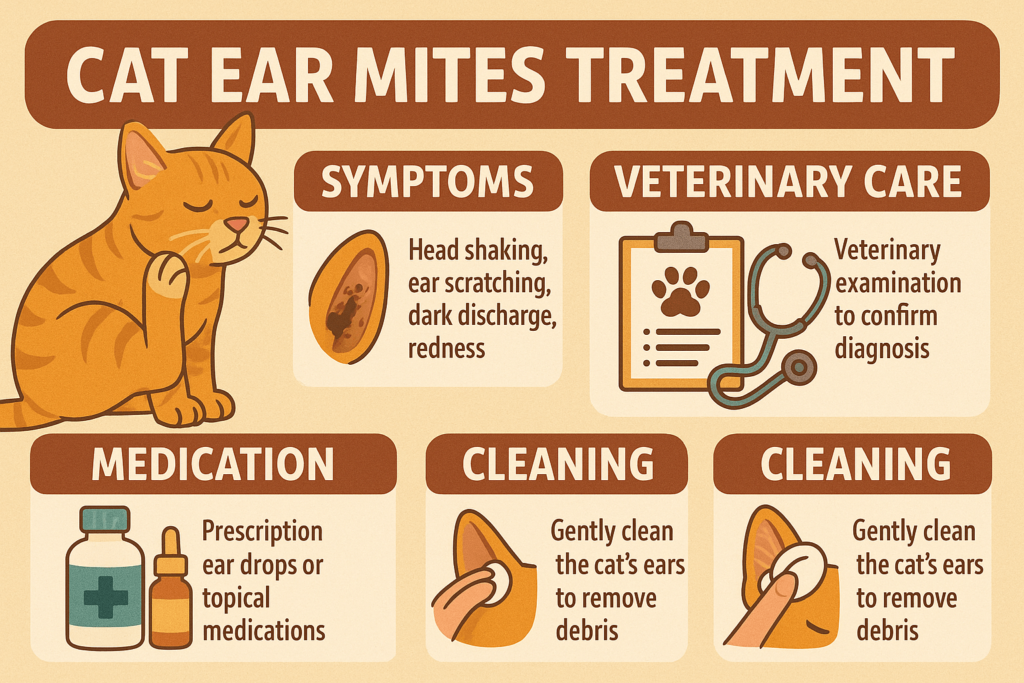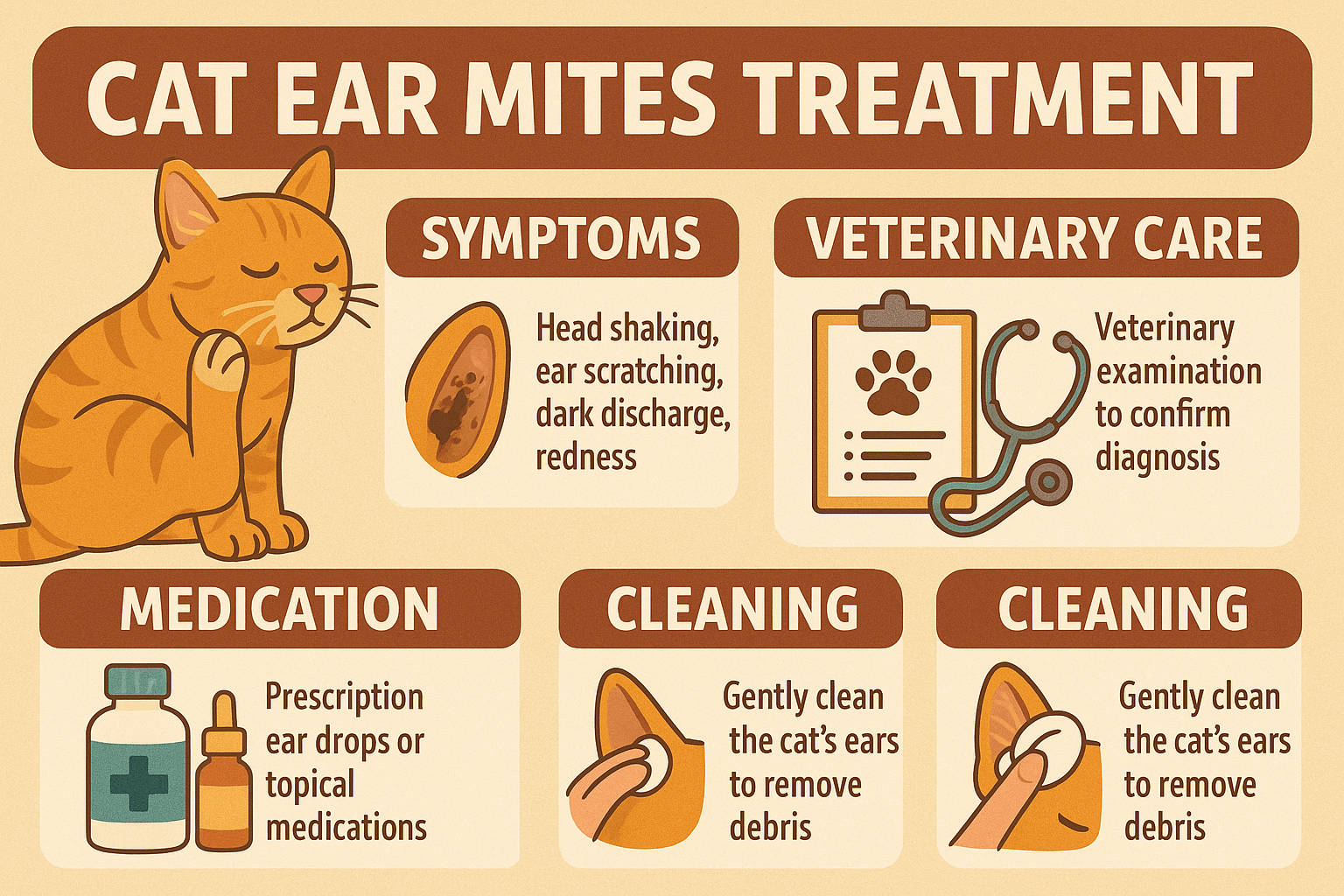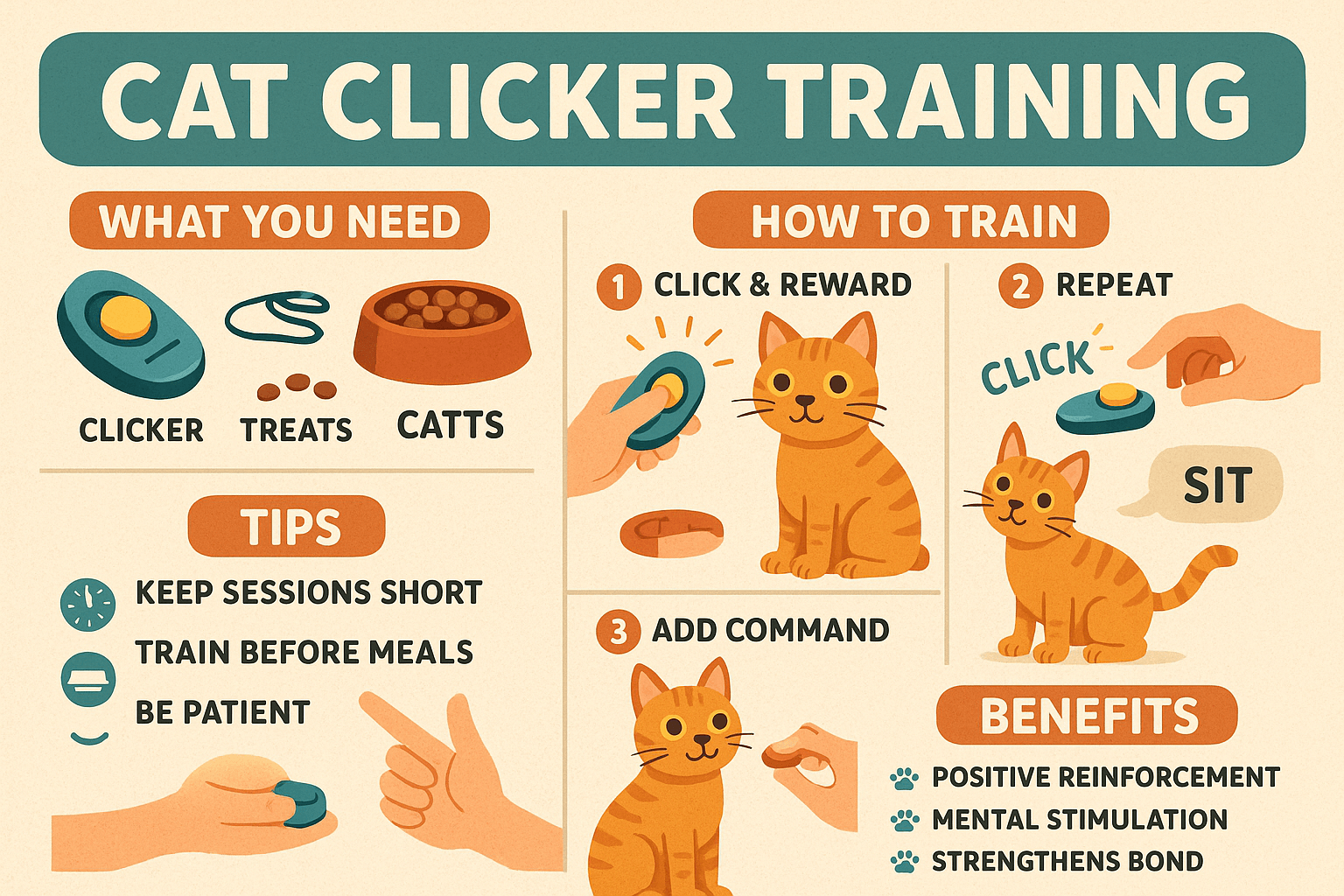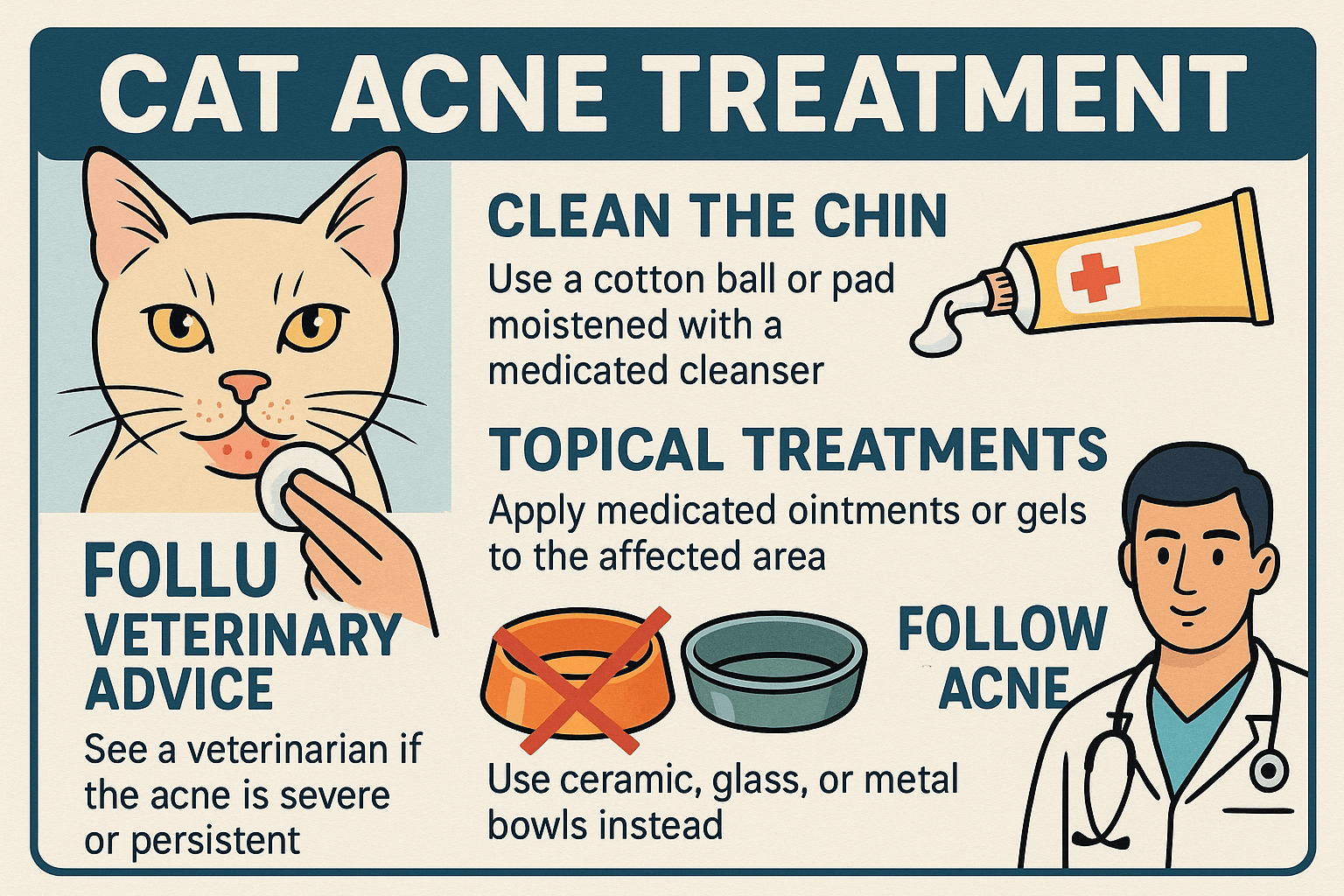Cat Ear Mites Treatment: How to Help Your Feline Feel Better
Ear mites are tiny parasites that can cause significant discomfort for your cat, leading to itching, irritation, and even secondary infections. These pesky critters are highly contagious and often spread between pets in close quarters. If you suspect your cat has ear mites, prompt treatment is essential to alleviate their symptoms and prevent further complications. In this guide, we’ll explore everything you need to know about identifying, treating, and preventing ear mites in cats. With the right care and attention, you can help your furry friend feel comfortable and healthy again.
Signs Your Cat May Have Ear Mites
Recognizing the symptoms of ear mites is the first step toward effective treatment. These signs can vary in severity but are typically easy to spot if you know what to look for.
Excessive Scratching at the Ears:
Cats with ear mites often scratch their ears relentlessly due to intense itching caused by the parasites.Shaking Their Head Frequently:
Head shaking is a common response to the irritation and discomfort caused by ear mites.Dark, Crumbly Discharge in the Ears:
A buildup of dark, coffee-ground-like debris in the ear canal is a telltale sign of ear mites.Redness or Inflammation Around the Ears:
The constant scratching and irritation can lead to redness and swelling in and around the ears.Unpleasant Odor from the Ears:
An unusual smell emanating from your cat’s ears may indicate an infection caused by ear mites.
If you notice any of these symptoms, it’s important to act quickly to address the issue and prevent further complications.

Effective Treatments for Cat Ear Mites
Treating ear mites involves a combination of cleaning, medication, and preventative measures. Here are some proven methods to eliminate these pesky parasites and restore your cat’s ear health.
Veterinary-Prescribed Ear Drops:
Medicated ear drops are often the first line of treatment, targeting and killing the mites directly in the ear canal.Thorough Ear Cleaning:
Gently clean your cat’s ears with a vet-recommended solution to remove debris and mite residue.Topical Flea and Tick Treatments:
Some topical treatments designed for fleas and ticks also work against ear mites, providing comprehensive parasite control.Oral Medications (if Recommended):
In severe cases, your vet may prescribe oral medications to address secondary infections or persistent infestations.Environmental Cleaning:
Wash bedding, vacuum carpets, and clean shared spaces to eliminate mites that may have spread to your home environment.
With consistent treatment and follow-up care, most cats recover fully from ear mites within a few weeks.
Check this guide 👉Cat Ear Mites vs Wax: Best 7 Expert Tips!
Check this guide 👉How Do Cats Get Ear Mites? Best 7 Expert Tips!
Check this guide 👉Black Dots in Cat Ear: Best 7 Expert Tips!
Treatment Options for Ear Mites | Preventative Measures Against Ear Mites |
|---|---|
Veterinary-prescribed ear drops | Regular ear inspections and cleanings |
Thorough cleaning of the ear canal | Keeping your cat indoors to reduce exposure |
Topical flea and tick treatments | Avoiding contact with stray or infected pets |
Oral medications for severe cases | Washing pet bedding and toys frequently |
Environmental cleaning and sanitation | Using preventative parasite treatments |
How to Clean Your Cat’s Ears Safely
Cleaning your cat’s ears is a crucial part of treating ear mites, but it must be done carefully to avoid causing harm or discomfort. Follow these steps to ensure a safe and effective cleaning process.
Gather the Right Supplies:
Use vet-recommended ear cleaning solutions and soft cotton balls or pads—never use cotton swabs, which can damage the ear canal.Restrain Your Cat Gently:
Wrap your cat in a towel or have someone assist you to keep them calm and still during the cleaning process.Apply the Cleaning Solution:
Squeeze a small amount of the cleaning solution into the ear canal and gently massage the base of the ear to loosen debris.Wipe Away Excess Debris:
Use a cotton ball to wipe away dirt and discharge from the outer ear, avoiding deep insertion into the ear canal.Reward Your Cat Afterward:
Offer treats or praise to create a positive association with ear cleaning.
Proper cleaning not only removes mites but also prevents secondary infections, ensuring your cat’s ears stay healthy.
Tips for Preventing Ear Mites in Cats
Prevention is key to keeping your cat free from ear mites and other parasitic infections. These tips will help you minimize the risk of infestation.
Regular Veterinary Check-Ups:
Schedule routine vet visits to monitor your cat’s ear health and catch potential issues early.Maintain a Clean Environment:
Regularly wash your cat’s bedding, toys, and grooming tools to eliminate mites or eggs that may linger.Limit Exposure to Stray Animals:
Keep your cat indoors or supervise outdoor time to reduce contact with stray animals that may carry mites.Use Preventative Parasite Treatments:
Monthly flea and tick treatments can also protect against ear mites, providing an added layer of defense.Inspect Ears Routinely:
Make it a habit to check your cat’s ears for signs of irritation, discharge, or unusual odor.
By incorporating these preventative measures, you can significantly reduce the likelihood of ear mites affecting your feline companion.
Common Mistakes to Avoid When Treating Ear Mites
Treating ear mites requires precision and care, but certain mistakes can delay recovery or worsen the condition. Being aware of these pitfalls ensures better outcomes for your cat.
Using Home Remedies Without Vet Approval:
Unapproved remedies like alcohol or hydrogen peroxide can irritate your cat’s ears and cause further damage.Skipping Follow-Up Appointments:
Missing vet check-ups may result in incomplete treatment, allowing mites to return.Neglecting Environmental Cleaning:
Failing to clean your home can lead to reinfection, as mites can survive off your cat for short periods.Over-Cleaning the Ears:
Excessive cleaning can irritate the ear canal and exacerbate inflammation or discomfort.Assuming Symptoms Will Resolve on Their Own:
Untreated ear mites can lead to serious complications like infections or hearing issues.
Avoiding these mistakes ensures a smoother recovery process for your cat.
Signs Your Cat’s Ear Mite Treatment Is Working
Monitoring your cat’s progress helps determine whether the treatment is effective. Look for these positive changes as signs of improvement.
Reduced Scratching and Head Shaking:
As the mites die off, your cat’s urge to scratch or shake their head will diminish.Clearer Ear Discharge:
The dark, crumbly debris will gradually disappear, leaving cleaner ears.Less Redness and Swelling:
Inflammation around the ears should subside as the irritation eases.Improved Mood and Behavior:
A more relaxed and playful demeanor indicates your cat is feeling better.No New Symptoms Appear:
The absence of new issues, such as foul odors or pus, suggests successful treatment.
These signs confirm that your efforts are paying off and your cat is on the road to recovery.
How to Comfort Your Cat During Ear Mite Treatment
Treating ear mites can be stressful for your cat, but there are ways to make the process more comfortable and less daunting.
Create a Calm Environment:
Choose a quiet, familiar space for treatments to help your cat feel secure.Offer Distractions During Treatment:
Provide toys or treats to redirect your cat’s attention and reduce anxiety.Use Positive Reinforcement:
Reward your cat with praise, petting, or snacks after each step of the process.Keep Sessions Short and Gentle:
Break tasks into smaller steps to avoid overwhelming your cat.Stay Patient and Reassuring:
Your calm demeanor reassures your cat and builds trust throughout the treatment.
By prioritizing comfort, you can make the experience less stressful for both you and your feline companion.
Frequently Asked Questions About Cat Ear Mites
Can humans get ear mites from cats?
While rare, humans can develop skin irritation from ear mites, but they cannot survive long-term on human hosts.
How long does it take to treat ear mites?
Most treatments take 2-4 weeks to fully eliminate ear mites, depending on the severity of the infestation.
Are over-the-counter treatments effective?
Some OTC products can help, but veterinary-prescribed treatments are generally more effective and safer.
Can ear mites lead to hearing loss?
Untreated ear mites can cause secondary infections, which may affect hearing, but prompt treatment prevents this risk.
Do indoor cats get ear mites?
Yes, indoor cats can get ear mites through contact with other pets or contaminated objects like bedding or grooming tools.
Helping Your Cat Overcome Ear Mites
Ear mites can be a frustrating and uncomfortable problem for your cat, but with the right knowledge and care, you can eliminate these parasites and restore your pet’s ear health. From recognizing the signs to following through with treatment and prevention, every step you take contributes to your cat’s well-being. Remember, your veterinarian is always your best resource for advice and support. By staying vigilant and proactive, you can ensure your feline friend enjoys a happy, itch-free life.
Cat Clicker Training: Best 7 Expert Tips! Discover how to train your cat using clicker techniques, improve behavior, and strengthen your bond with simple, effective strategies.
Lorem ipsum dolor sit amet, consectetur adipiscing elit. Ut elit tellus, luctus nec ullamcorper mattis, pulvinar dapibus leo.
Cat Ear Mites Treatment: Best 7 Expert Tips! Discover effective solutions to treat and prevent ear mites in cats, ensuring your pet's comfort and health with expert advice.
Cat Acne Treatment: Best 7 Expert Tips! Discover effective remedies, prevention strategies, and expert advice to treat and manage feline acne for a healthier, happier cat.



